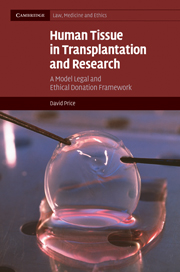Book contents
- Frontmatter
- Dedication
- Contents
- Preface
- Table of cases cited
- Table of selected statutory sources
- Introduction
- 1 Human biological materials
- 2 Interests in the living body and corpse
- 3 Eliciting wishes
- 4 Consent to donation
- 5 Presumed consent
- 6 Informed consent
- 7 Living donation
- 8 Property in human material
- Conclusion
- Index
- References
3 - Eliciting wishes
Published online by Cambridge University Press: 05 July 2014
- Frontmatter
- Dedication
- Contents
- Preface
- Table of cases cited
- Table of selected statutory sources
- Introduction
- 1 Human biological materials
- 2 Interests in the living body and corpse
- 3 Eliciting wishes
- 4 Consent to donation
- 5 Presumed consent
- 6 Informed consent
- 7 Living donation
- 8 Property in human material
- Conclusion
- Index
- References
Summary
As Healy states ‘The key question of consent in organ procurement is essentially one about the source and degree of authority over the dead: Who, in principle, controls the decision to procure?’ In this chapter we are primarily considering deceased donors, in so far as it is unambiguously the entitlement of competent living patients rather than others to generally determine the use of their body parts. I seek to address this question of ‘whose wishes count’, to explore the relative weight to be afforded to the wishes of the various actors, and how these should be prioritised and balanced in the event of differences. This necessarily reflects the interests identified in chapter 2, transplanted into a concrete, practical context. Although very much of the material below emanates from the transplantation sphere, it is equally generalisable to the research context.
Who is the donor?
The ‘donor’ is typically equated to the ‘primary decisionmaker’. For instance, Healy states ‘In practice, though, the decision to donate is made by the deceased person’s family or next of kin. They are the real donors’ (my emphasis). This last comment is grounded in the customary practice in the US, which also finds reflection in the UK, Australasia and most other parts of the world with explicit consent systems, and even in some presumed consent jurisdictions. Nonetheless, an alternative view is evolving. The 2006 version of the US Uniform Anatomical Gift Act (UAGA), for instance, states that the donor ‘means an individual whose body or part is the subject of an anatomical gift’. The ‘gift’ is that of the person from whose body such material is taken and used. This is no mere semantic quibble.
- Type
- Chapter
- Information
- Human Tissue in Transplantation and ResearchA Model Legal and Ethical Donation Framework, pp. 77 - 98Publisher: Cambridge University PressPrint publication year: 2009



